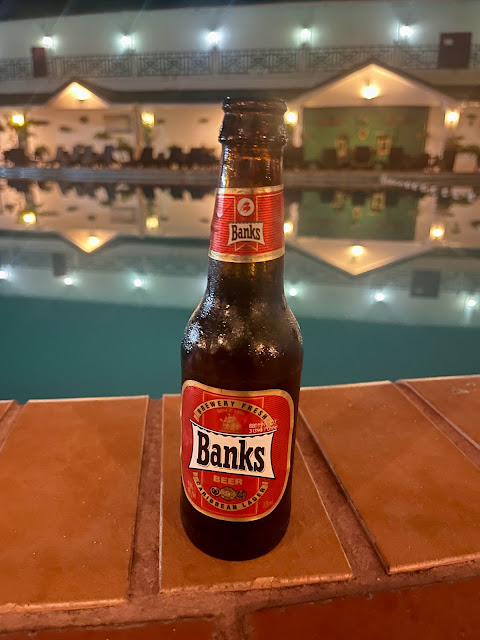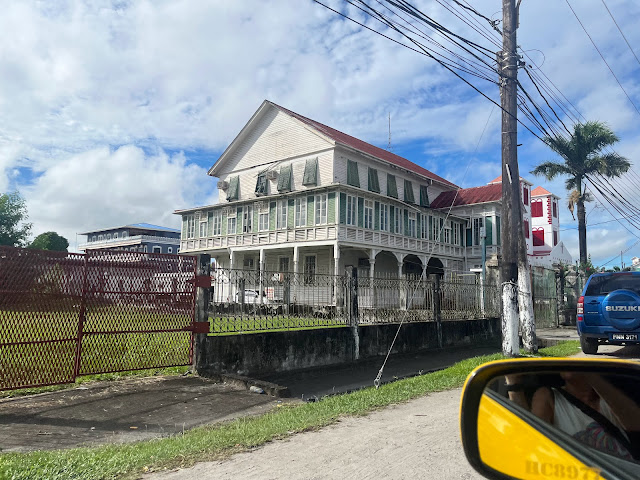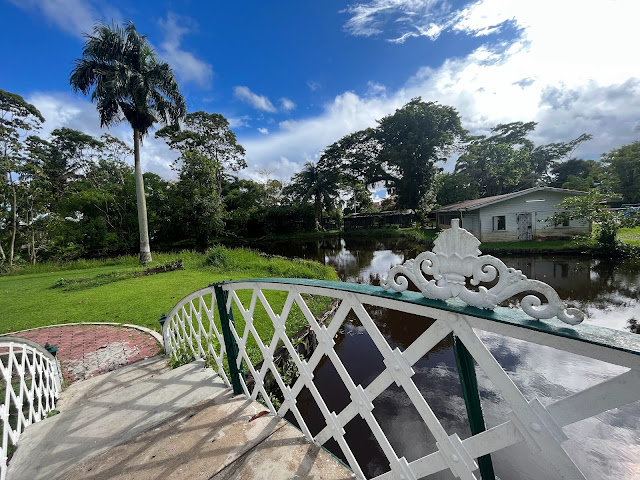Country #123: Gallivanting in Guyana
Sometimes all you can get is a quickie. Such was the case with country #123. The excitement on visiting my sole remaining South American country was tempered (and then tempered again) by an ever changing schedule that kept reducing the length of my stay. By the time I touched down in Timehri, Guyana, it was 1am. I was only going to have 11 hours, most of them in the middle of the night.
Add to this an hour’s drive to our hotel in Georgetown and I was down to 10 measly hours. Damn you, slow front desk clerk!! Why am I only seeing my room at 2:15 am? Resigned to missing out on the city’s sights, I figured I could at least try the city’s beer. I headed down to the 24 hour casino, where in a perverse turn of all things casino, they did not sell drinks. Sure, you could gamble and get free drinks but if you didn’t happen to have a fistful of Guyanese dollars to feed into the slot machines, you were shit out of Banks. Since at this point, down was up and up was down, the pool bar- the one without a soul in sight, maybe because it was the middle of the fricking night-was actually open and praise Zeus, willing to sell me a frosty beverage.
It was 3am, when I finally laid my weary head. Said head was still feeling pretty weary when daylight woke me up three hours later. It was 6am, the sun was blazing and the view outside my room was looking pretty sweet. I still had 5 hours to go and a raging case of FOMO. One call to the front desk later, I had a driver to take me around the city and show me the highlights (or as many as he could fit into a 2 hr window).
Riding shotgun (which happened to be on the wrong side of the car) with my new buddy, Elvis, we were off and running. We started with a drive across the Demerara Harbour Bridge, which is way more exciting than it sounds. The bridge is floating on pontoons, and held in place by what look like a series of buoys. I’ve been on floating docks before and have always felt like I was one jelly donut away from sinking the whole damn thing. To be in a car, alongside other heavy looking vehicles, was asking for a whole lot of faith in floating technology. Not even the architect, John Patrick Coghlan, was so sure about this thing. He gave the bridge ten years top. That was in 1978. Yet, it is still floating and even has a portion that retracts to allow boats to pass through.
Next up we did a drive-thru of the Sunday market, a surprisingly busy (at 7am!) farmer’s market. Any ideas I may have had of getting out to inspect the produce was quickly quashed when Elvis insisted I roll up the window. It honestly did not look or feel dangerous but I think he was wary of the attention that an obvious tourist would draw.
With its abundant rain forests and resident jaguars, Guyana has the potential of being a major eco-tourism draw. Sadly, due to a history of political instability and economic crimes, that is not the case. Nowhere was this more evident than when Elvis and I were walking along the seawall and a guy called out to ask if a diplomat. I responded that while I was not a diplomat, I did always try to be diplomatic. That ruled out, he declared that I must work for the UN. Are those really the only "tourists" they see, diplomats and aid workers?
The seawall itself did double duty. It was both a bulwark against the rising tides of the Atlantic Ocean and a promenade to be enjoyed by people of all ages. Looking out to sea, you could note where the Demerara River meets up with the Atlantic, each refusing to take on the color of the other.
But you know what you couldn’t see? A lighthouse. It’s not that Georgetown does not have one. It most certainly does, only it is almost 5 blocks inland and has a giant Marriott hotel between it and the nearest body of water. Isn’t the entire purpose of a lighthouse to warn boaters they are about to run out of ocean. This location makes no sense to me. By the time a seaman lays eyes on this thing, he has already lodged himself firmly atop the Marriott’s breakfast buffet.
Perhaps it is because of these past nautical mishaps that ferry crossing the Demerara river requires their passengers to actually don life vests for the 5 minute ride.
One particularly cool site was Umana Yana, a circular thatched roof building constructed using indigenous building techniques (read: not a single nail required). We were not able to go inside because it had been rented out for a private event but we did explore the grounds a bit.
Across the street sits a brightly colored “I heart Guyana” sign. There may not be a lot of tourism but those diplomats and UN workers are still getting their Instagram photo op.
Along the route, there were plenty of lovely colonial era buildings but none more impressive than St George’s Cathedral. Built in 1892, it is said to be the world’s tallest wooden building. It’s not, as of 2019, that title belongs to Mjostarnet in Norway but I heard the claim enough times to believe that it has to be at least in the top ten.
 |
| Possibly the World's Tallest Wooden Church |
Next stop was the Botanical Garden, a lovely park frequented by manatee. They may not be strolling along the well-maintained paths but they are known to hang out in the canals. That wasn’t the case on this particular Sunday morning but it was worth the stop nevertheless.
The park is also home to the Place of the Seven Ponds, a monument honoring a number of Guyanese heroes buried on the grounds.
We had already covered a lot but thanks to the relatively compact size of the city, we still had time for one last stop at the 1763 Monument, commemorating a slave rebellion that was a major part of the country’s anti-colonial struggles.
The time had flown by. I had only two hours remaining in this lovely country. It was not enough but then again it never is. I was just grateful I had gotten to see as much as I had. As far as quickies go, this one had been surprisingly satisfying.



























Comments
Post a Comment